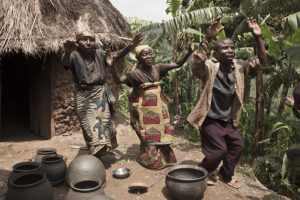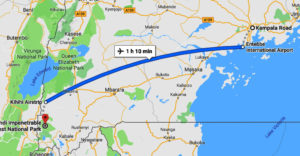If you’re planning your next safari to Uganda, a visit to Bwindi impenetrable national park definitely has to be on your travel bucket list. The park offers visitors with a variety of biodiversity to see making your journey here worth the money.
Bwindi was formerly known as crown forest in 1932 and at the time it had two sections of the south and north block designed as Kasatora crown forest. At the time, the forest covered an area of 207 square kilometers and was protected under the Uganda forestry body known as Uganda government forest reserve.
Later after almost 59 years, Bwindi impenetrable national park was established to act as a habitat for the endangered mountain gorillas which forced the government to relocate the Batwa people out of the forest. The group now settles in the surrounding areas around the park.
 Location of Bwindi impenetrable national park
Location of Bwindi impenetrable national park
Bwindi impenetrable national park is located in south western part of Uganda at the edge of a rift valley and is part of the ancient Bwindi impenetrable forest. The park borders Kabale in the south east, DRC in the west and Rwanda in the south.
Size of the Bwindi impenetrable national park
Bwindi covers an area of 331 square kilometers composed of both low land and montane forest and is raised on an altitude of 1,190 to 2,607 above sea level. However, about 60% of the park is raised above 2,000 meters above sea level with Rwamunyonyi hill found in the eastern edge and lowest part of the park marked as the highest elevation.
It became popular because of hosting almost half of the world’s population of the endangered species of mountain gorillas-about 400 live here. Nothing is as satisfying as getting close to man’s closest relative. It’s a once a lifetime opportunity you shouldn’t miss out.
Attractions in Bwindi Impenetrable National Park
This park hosts a vast of both animal and plant life giving travelers a chance to see a lot. What you will be able to since while in Bwindi Impenetrable national park includes: the endangered mountain gorillas, bird species like; Hairy-breasted Barbet, Montane Oriole, Forest Robin, Narina’s Trogon, Grey-throated Barbet, white-bellied robin-chat, equatorial akalat, willcock’s honeyguide, black bee-eater black sparrowhawk and more, L’hoest monkeys, black and white monkeys, colobus monkeys, forest elephants, bush bucks, African golden cats and more. Visiting the Batwa people does give you another extra ordinary feeling especially getting to see how they live their lives and associate with each other. This group of people will also entertain you where you can choose to be part of the traditional dances, maybe you could learn a few moves.
While here you will be able to visit Bwindi’s different gorilla trekking sectors with each sector having a specific gorilla family that inhabit it led by the male silverbacks.
Activities in Bwindi Impenetrable National Park
Gorilla trekking; known to be home to almost half of the world’s population of mountain gorillas, this makes Bwindi a top destination for gorilla trekkers from around the world. There four gorilla trekking trails in Bwindi where you will get to join a group of 8 people into the jungle to go and search for these species. These sectors include:
Buhoma; This particular sector is located in the northern part of the national park. It acts as the parks headquarters and will offer you with the best experience because it can easily be accessed due to its topography and it’s the closest compared to the other sectors. While here, you’ll be able to track different gorilla families from Mubare first identified in 1992 and consists of only 5 individuals, Rushegura habituated and trekked in 2000 with now 13 individuals and Habinyanja which was habituated 1997 and trekked in 1999 and inhabits about 13 individuals.
Ruhija: This sector is located in the north eastern part of the park just 45km away from Buhoma. Gorilla trekking in Ruhija is great since the area is not too hilly and steep compared to the other sectors found in the south of the park. while here, you will be able to get close and observe different families of the great endangered mountain gorillas as they roam through the park. gorilla families found in this park include; Oruzigo, Mukiza, Kyaguriro and Bitukura family. All the four gorilla groups are open to tourists for tracking. 32 gorilla trekking permits are given out daily for gorilla trekking.
Rushaga; Located in the south part of the park, Rushaga is considered to be the best area for gorilla trekking given the fact that it hosts much more gorillas compared to the other sectors. Rushaga also is home to five different gorilla families that is; Nshogi, Mishaya, Bweza, Kahugye, Mucunguzi, Bikyingi and Busigye family. There 56 gorilla tracking permits are available to gorilla trekkers each day in this sector.
Nkuringo: Habituated in the southern part of the Bwindi, Nkuringo sector inhabits Nkuringo family which was named after its leader the silverback, Nkuringo who later passed away and was replaced by silverback safari. The gorilla family all together comprises of 19 members. Apart from gorilla trekking, the panoramic views of the Virunga Volcanic Range, make it one of the destinations worth visiting.
Gorilla trekking permit costs and how to go book one
Gorilla trekking in the above sectors is only limited to eight people per gorilla group. However, if one does want to spend more time than that which is known as gorilla habituation, its allowed and a tourist will have to pay a cost of $1,500 for foreign non residents, $1000 for foreign residents and Ugx 750,000/=.
Trekking permits for an hour cost $700 per person for foreign non residents, foreign residents $600 per person while tourists from within East Africa pay Ugx 250,000/=.
You are advised to book your permit before your safari to Uganda either directly through Uganda wildlife authority or using a registered and trusted tour operator like us. Booking your permit with Vizuri Africa Safaris comes at a cheaper commission compared to the rest simply because there a few administrative costs involved the drive Uganda wildlife authority and more.
Gorilla trekking aside, there a number of other activities that take place within the park and they include;

Birding: Bwindi is one of the top destinations for birders and this can be witnessed by the recognition the park received in 2011 as Africa’s number one spot for birding. The park has over 346 bird species, among them 14 species are endemic to Bwindi impenetrable national park, while 23 species are only found in the Albertine rift. The birds found here include; short tailed warbler, blue headed sunbird. Bwindi also hosts migratory birds that can be seen during the months of November and April.
Cultural tours; This is yet another unique activity one has to do while in Bwindi. Experience the unique culture and lifestyle of the Batwa people who initially settled within the park but were later relocated to areas surrounding the park.
 While here, you will receive an incredible performance from the cultural dancing group. In sectors like Buhoma, you will be allowed to explore the community and here you discover hand craft shops that do sell crafted items like the fabrics, beeswax candles, wooden carvings etc.
While here, you will receive an incredible performance from the cultural dancing group. In sectors like Buhoma, you will be allowed to explore the community and here you discover hand craft shops that do sell crafted items like the fabrics, beeswax candles, wooden carvings etc.
Nature walks; Walking through the park with the help of the guides using the already established walking trails is a stunning experience. Imagine being in a quiet place while enjoying the sights and sounds of nature. The activity that lasts for 1hr to 8hrs offers tourists a chance to explore the ancient Impenetrable Forest discovering new plant and animal species that are rarely seen. Like the different butterfly species, tree species, birds and more. Nature walks in the park range from moderate to challenging especially in steep areas of the park that do require some effort. But this activity is worth being part of.
Cycling/ mountain Biking; This incredible activity is organized by Buhoma Community Rest Camp under Ride 4 A Woman group. The riding usually takes about 5hrs through the trails within the park. this activity offers a tourist to view the beautiful landscape, get to see different bird species as they sing in the sky. You can as well opt to ride within the village and here you will get to see how the community set up is and their life time.
Another ride is to and from river ivy through then trails that do exist within the park and this gives a tourist a chance to also come close to wildlife like monkeys, squirrels, and you might also be able to spot some gorillas too.
Best time to visit Bwindi impenetrable national park
Tourism in Bwindi impenetrable national park as whole is considered to be an all-year success however the best here is during the drier season of the year when the rains are less which does occur during the months of June to September and December to February. During this time, the trails within the park are less slippery compared to during the wet season when the park receives heavier rains. The rains fall during the months of March to May and October and November.
During this wet weather pattern, there are more mosquitoes and the mist is always too much which may be a barrier to view the incredible and beautiful landscape. Despite the different weather patterns, a safari to Bwindi impenetrable national park is a once in a lifetime trip you shouldn’t miss out.
Accommodation in Bwindi Impenetrable National Park
Over the years accommodation in Bwindi impenetrable national park has been growing and as of today, the park offers accommodation services ranging from luxury, midrange to budget. In Buhoma sector Engagi Lodge and Haven Lodge are among the luxury. In the mid-range, mahogany springs and Buhoma lodge Bwindi are reliable favorites, while gorilla forest camp and volcanoes Bwindi lodge will work for those would prefer low budget.
In Ruhija gorilla trekking sector, there is a number of lodges and these are; Agandi lodge, Bakiga lodge, broadbill forest camp, chameleon hill lodge, Ruhija Gorilla Safari Lodge, Trekkers Tavern cottages and more.
In Rushaga sector, you will be to rest in lodges like; Gorilla Safari Lodge, Bwindi jungle lodge, Gorilla valley lodge, Lake Mulehe gorilla lodge and more. While in Nkurigo you can rest in; Crested crane lodge, Nkuringo Bwindi gorilla lodge, Virunga campsite and more.
How to get there
Bwindi impenetrable can be accessed by both road and air. By road, it’ll take you about 8-10hrs to get to the park via Masaka Rd and Mbarara-Masaka Rd 540km from Kampala, Uganda.

You can also access it using a chartered plane from Entebbe international airport or Kajjansi airstrip to Kihihi airstrip in Rukungiri which is a few kilometers away from Buhoma or Kayonza airstrip. You can also fly to from Entebbe to a now tarmacked Kisoro airstrip.
Including Bwindi impenetrable national park on your itinerary is worth. After the safari, there’s no way you will forget the memories encountered here.
